Note (Updated for 2025):
As of December 2024, GUE split the Fundamentals class into two tracks—Recreational and Technical. This post covers my experience in the pre-2025 combined version, but much of it will still apply to the new split format.
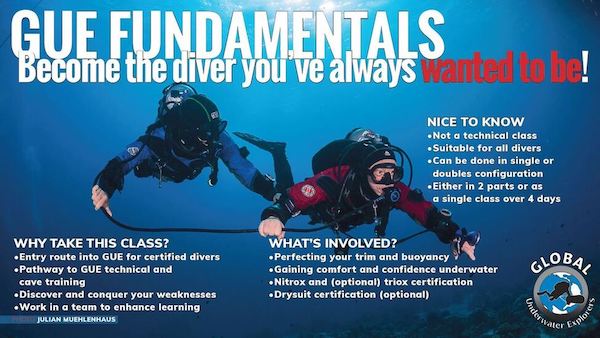
What Is “Fundies”?
In short: It’s how previously trained Open Water divers “cross over” into the GUE system.
When you pass the Recreational version of Fundies, you’re issued a certification equivalent to Open Water Diver (EN 14153-3 / ISO 24801-2) and Nitrox (ISO 11107). GUE does not recognize Open Water certifications from other agencies within its system because the skill proficiency standard is higher.
Why Take Fundies?
As a recreational diver, it’s the single best dive training you can take. Full stop. Many divers take Fundies without ever planning to continue in the GUE system—just to become better divers.
Do you want to:
- Know exactly why your trim or buoyancy is off?
- See what true team diving looks like?
- Get detailed feedback on every move you make?
Example
My instructor gave me feedback on how I was grabbing my primary regulator during a reg-in/reg-out drill. She asked me to rotate my hand by about 15 degrees so the reg would naturally point down and be less prone to free flow.
Was I doing it wrong? No.
Was there a better way? Absolutely.
That’s the level of coaching you get.
GUE’s system is designed “with the end in mind”. Once you learn the procedures, they don’t change. A GUE Tech 2 diver and a Rec 1 diver will dive with the same base procedures, equipment, and expectations.
How Much Does It Cost?
There are three major components:
- GUE Registration Fee
- Instructor Tuition
- Shared Instructor Expenses (travel, lodging, gas fills, etc.)
What It Cost Me:
- Registration: ~$95
- Tuition: ~$900
- Shared Expenses: ~$500
- Total: ~$1,500
It felt like taking Open Water, a bunch of specialty classes like Nitrox, Science of Diving, Navigation, Night & Limited Vis, Drysuit, and Peak Performance Buoyancy... all in one.
What Equipment Do You Need?
If you're not already using a backplate and long-hose setup, you will need to source or rent gear that conforms to GUE standards. Jacket-style BCDs, split fins and dangling accessories are out.
I was already diving this style of gear from my own research before I even knew about GUE, so I didn’t need to buy anything new. But that’s not typical.
Reach out to your instructor in advance. They’ll help confirm your gear meets standards.
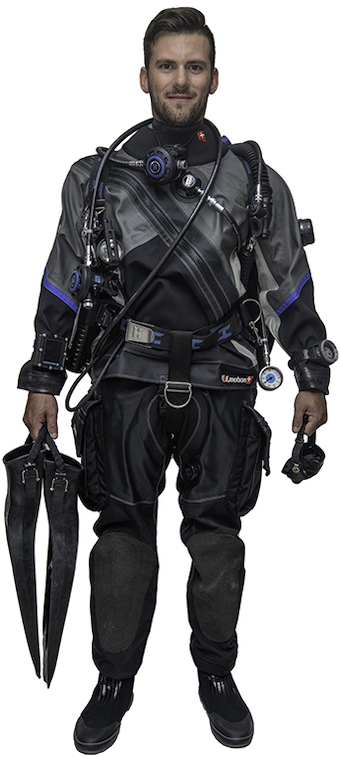
Required Gear for a Recreational Pass
- Backplate and wing with continuous harness (no quick-release buckles)
- Single crotch strap
- Five D-rings only: (Left chest, right chest, left hip, butt, crotch)
- “Technical” style fins
- Primary and backup masks (preferably with neoprene straps)
- Wetsuit or drysuit with thigh pockets (tech shorts required with wetsuit)
- Regulator with long hose, necklaced backup, analog SPG
- Dive computer (no/disabled air integration modules)
- Compass
- Primary light
- Backup light
- Optional: Canister light (not required or recommended for Recreational pass)
- If not using a canister light, a long hose stick helps with routing
- dSMB and spool (100ft of cave line)
- Wetnotes (I never used them, but they’re part of the standard loadout)
How Hard Is Fundies?
Very. It was the most intense dive training I’ve ever taken—and I’ve taken a lot.
This is not the kind of class where you get a gold star for clearing your mask. You’ll get honest feedback, both good and bad. They’re kind, but direct.
Bring your big kid pants and leave your ego in the car.
The bar is high. But if you’re serious about becoming a better diver, that’s exactly what you should want.
My Advice Before You Take Fundies
- Get in shape. Cardio, legs, and recovery matter more than you think.
- Practice both swim tests. You can do them on your own.
- Avoid cramps. Eat well, hydrate, and stretch.
- Drink water constantly. Always have water in your hand on the surface.
- Try for a tandem instructor class. It’s worth the cost.
- Tech Pass? Be sure. You’ll need perfect buoyancy, a canister light with Goodman handle, doubles, and no weak points. Go fun dive with a GUE Tech diver and ask them if you’re ready.
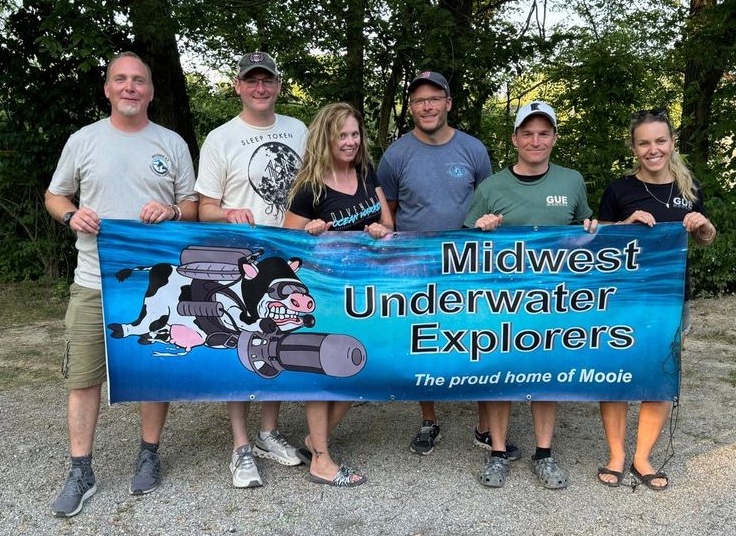
What Does the 4-Day Class Look Like?
Every GUE Fundies class follows a common structure, but the order and pace vary based on location, weather, and student skill.
My class was taught by Emőke Wagner (world-class cave diver) and Francesco Cameli (world-class tech/wreck diver). Together, we logged over 6 hours underwater across 4 days, with one dive lasting 83 minutes.
These weren’t sightseeing dives. Every dive was loaded with new tasks, challenges, and coaching.
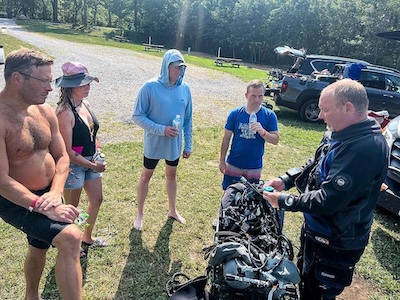
Day 1 – Thursday
- Paperwork and intro classroom session
- Gear overview and reconfiguration
- Dive 1
- GUE EDGE pre-dive briefing
- Weight checks (I removed 30% of my normal weight!)
- Baseline skills evaluation
- Feedback:
- Keep your head up
- Stop with the “happy feet”
- Additional class session
Day 2 – Friday
Emőke knew that I was going to be diving in Lake Michigan in a drysuit and encouraged me to switch to my drysuit for the rest of the class, even though I had less than 10 dives with it.
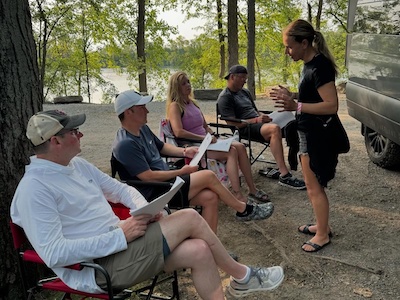
- Classroom session
- Underwater swim test (50ft) — failed, then passed
- Surface swim (300 yards in 14 min) — completed in 6 min
- Nitrox/O2 analysis (32% standard)
- Dive 2
- Improve kicks
- First run of the Basic 5:
- Mask clear
- Mask removal/replacement
- Reg in/out
- Switch to backup
- Long hose donation
- Feedback:
- Keep your head up
- Don’t T-Rex your arms
- Dive 3
- Repeat kicks + Basic 5
- First valve drill (I failed)
- Feedback:
- Head up...again
- Arms out...again
- Back kick needs work
- Underwater video review (super cool to watch)
Day 3 – Saturday
- Mid-Class Evaluation:
- Great attitude
- More team awareness needed
- Improve trim under load
- Rec Pass still on the table
- Dive 4
- Francesco switched fins with me to test if they were contributing to my cramping
- Repeat kicks + Basic 5
- Valve drill (failed again)
- No-mask swim (buddy got feedback for steering me into things - hahaha)
- Feedback:
- Head and arms still need work
- Back kick improving
- Fins (Deep6) and Rock boots likely contributing to “stiff” kicks and cramps
- S-Drill Introduced
- Dive 5
- First S-drill attempt
- Feedback:
- Better head position
- Trim improving
- “Happy feet” still present, but improving
Day 4 – Sunday
I was mentally and physically exhausted at this point from the prior 3 days and talked to Emőke about possibly not continuing. She encouraged me to continue as I only needed one more dive to complete the class and at least get a "provisional" if not a "pass".
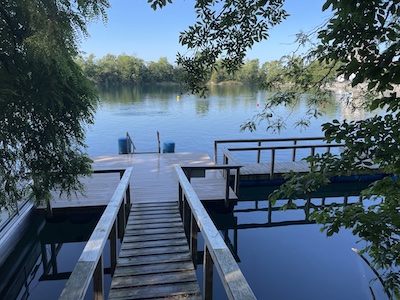
- Final Written Exam:
- No joke — required written answers and showing your work. I passed.
- Underwater video review
- Dive 6
- Continue improving kicks
- Valve drill (success!)
- S-drill again
- Backup mask deployment (first time)
- dSMB deployment and ascent (first time)
- Feedback:
- Excellent team awareness
- Buoyancy on ascent still needs work
- Dive 7
- dSMB deployment and ascent
- dSMB deployment and ascent
- dSMB deployment and ascent
- Feedback:
- Much better buoyancy control
Final Feedback
- You PASSED
- Great attitude during the entire class
- Took the feedback without excuse or pushback
- Very glad to see me switch to drysuit on day 2 even though I could have continued in a wetsuit and made it easier on myself
- Excellent teammate with good situational awareness
- Significant and material improvement from day one to day four
- Francesco gave me some ideas for additional buoyancy and "happy feet" training that I can do at any quarry with a platform
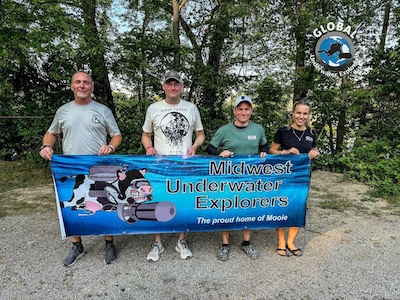
Official Final Evaluation Notes
Tyler is a very committed diver who greatly improved during the 4 days. He had a very solid performance and acted as an excellent teammate. Tyler developed a solid platform for recreational diving, his kicks are overall nice, drills and procedures are precise and awareness exceeded minimum standards. Trim has to be more consistent especially when task loaded by avoiding fin tips dropping down, and by keeping core tension. Tyler has the tendency to drop his head, he is aware of it. Buoyancy on ascents with and without task load has to be practiced in order to gain more confidence and memory about when and how much gas has to be vented [Tyler: from drysuit]. We recommended changing his fins to more flexible ones like OMS Slipstreams, Hollis F1 or Jetfins. Changing the backplate is also something to consider since waist strap is running too low.